

Article fait par :Claude Balmefrezol
Mis en ligne le

The IJN Yamato (大和), is one of the most famous ship of the WW2 Why ?
Because tue IJN Yamato battle ship class were the largest, heaviest, and most powerful battleships ever constructed, displacing 72,800 tonnes at full load, and armed with nine 460 mm (18.1 inch) main guns
The IJN Yamato was the Flag ship of the Japanese combinet Fleet during WW2 He has as sister ship the Mushashi
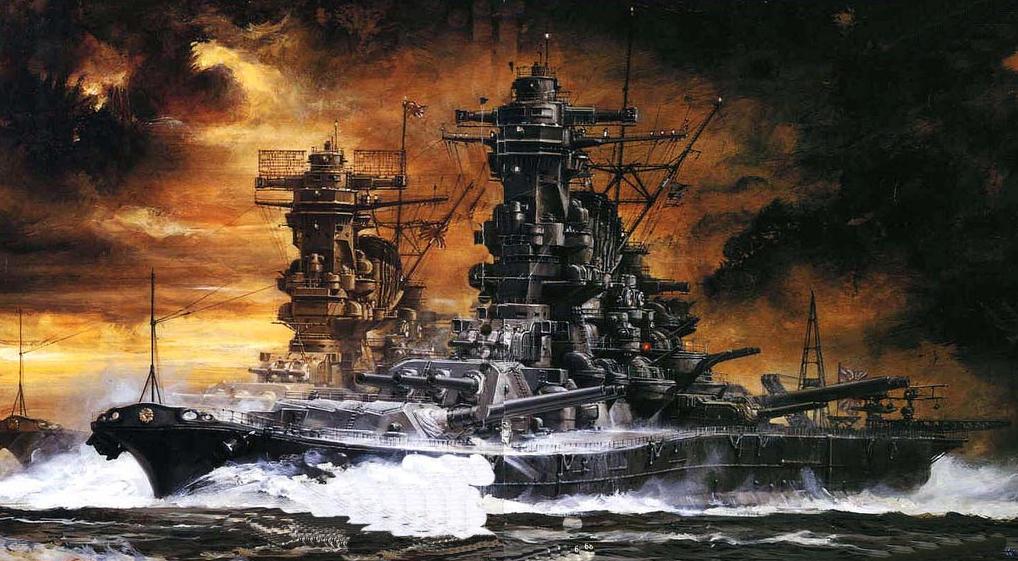 |
| IJN Yamato and IJN Musashi (Internet) |
He was constructed from 1937-1940 in Kure dok yard commissioned in 1941, Yamato was subsequently involved in every major surface naval-battle of the Pacific War except Guadalcanal Yamato was sunk on April 7th 1945 during Operation Ten Go
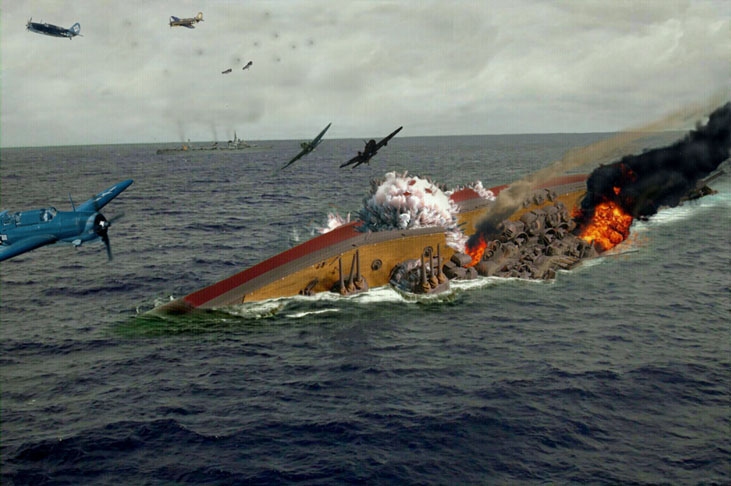 |
| The End (Internet) |
History
The Japan rise at a big power statut after his victory against the Russin empire in 1904 . His Navy was one of the major fleet in the Wordl but the lmajortity of his ships were built outside of the Japan In Great Britain or France . The fleet could be could be maintainedthroughout the Pacific the Japanese Power and influence
Being allied during WW1 do not exclude competition between Japan and USA
So Japanese naval strategy after WW 1 included plans for the construction of a fleet powerful enough to intimidate all opponents, in particular the United States Navy
This plan respond to the American naval construction plan of August 1916, which called for "a fleet secondto none,"
the Japanese plan considered vital by the political power was called "8/8," approve the construction of eight battleships and eight battlecruisers.
With this Fleet Japan strengthen his position in the Far East and secure itmilitarily, and to counter growing opposition from theUnited States especially
Although these plans were curtailed Japan's participation to the Washington Naval treaty of 1922, With the agreements of his Naval Treaty of 1922, Japan was forced to amend her construction plans. Nine battleships and three battle cruisers were scrapped on the ways as a result of this Treaty. Two battleship KAGA and battle cruiser AKAGI, were spared and converted into aircraft carriers
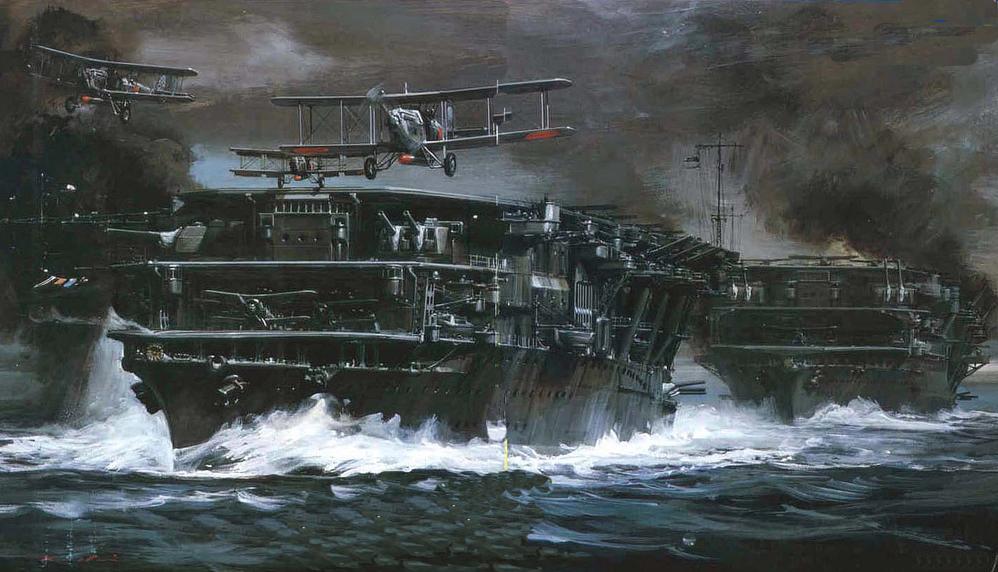 |
| IJN AKAGI and IJN KAGA Prior 1930 (Internet) |
But Japan continued technical studies and in 1933, a new class of battleship would feature main armament with a barrel-caliber of 460 mm
But international sanctions in 1934 (invasion of the Manchuria ) led Japan to withdraw from the SDN and in 1936 the Washington Treaty and his obligations
Soon after the preliminary design of the future YAMATO class, were drawn up because during all this time IJN engineers have already t work on the design for this super-battleship
This battleship class would be armed with 9 x460 mm or 18-inch gun ( highly secret weapon )with a secondary battery comprising four turrets armed with 12 x 155mm guns in 4 turrets, or 8 203 mm guns in 4 turrets
The defensive armor capable of withstanding a bombardment of 460mm from a range of 20,000 to 35,000 meters, The ship has an immune zone is defined as the range band, within which the armor of a ship is theoretically immune to penetration. In this example, at ranges of less than 20,000 meters, shells will have sufficient energy to penetrate the vertical armor plates, but will strike at too shallow an angle to penetrate the horizontal deck armor. At ranges greater than 35,000 meters, shells plunging at steep angles will have sufficient energy to penetrate horizontal deck plates, but will bounce off vertical plates. Within this zone, neither plates can be penetrated All that theoretically
He would have a top speed of 30 knots, and a cruising range of 8,000 nautical miles (14,800 km) at a speed of 18 knots.
The Dream
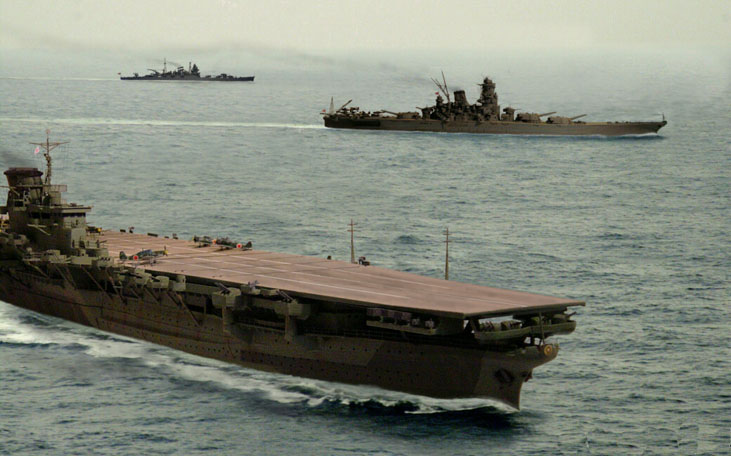 |
| Shinano Yamato and Musashi( the Dream ) (Internet) |
The construction of 7 YAMATO class ships was approved in 1936, which would enter service in 1941. During this same time period When the YAMATO’s class entered service, the construction of 4 SUPER YAMATO battleships armed with six 508 mm (20 inch ) would be start, two of which became designs 798 and 799; with completion estimated for 1946. During this time period USA would probably posses new battleships 406mm or 16 inch gunned and start the construction of the first ships armed with the 457mm or 18- inch gunned
On 1946, Japan would then begin rearming the seven original YAMATO class ships with six 508 mm or 20-inch guns at the same time the four SUPER YAMATOS entered service.
In this weapon race USA would be ready only on 1951 for the 508mm gun So for the Japan victory could be assured only by intimidation and the Pacific become their "Peace Goddesses of the Pacific," and if perhaps war was unavoidable, the super battleships of the IJN would be irresistible. But this plan was a dream because Japan start war against USA so soon. And the criteria change . The Carrier Aircraft Era was ready to born
The reality
Return to the reality In Japan the best naval architect at that time, wasCaptain Kikuo Fujimoto, the chief designer in the Naval Technical Bureau. His design clearly showed a exceptional vessel the mighty never see
The earliest version of the future Yamato was the Plan No. A-140 A for battleship and 140 indicating that this was the 140th warship designed by the IJN was completed in March 1935
He show a ship with Displacement Standard of 50,000 and Trials displacement of 59,000 . He as 241 m long at the waterline with a 31m beam, a 8 m draught, and a trial. One notable feature of this and other early designs is that all three turrets of the main battery( 508mm or 20 inch ) are concentrated forward of the ship's superstructure The armor was for the Main Belt of 40 cm and the Deck 27 cm the Power Plant was a mixed turbine/diesel which allow 30 knots speed He has a range of 12,000 nautical miles at 16 knots He has also 12 aircrafts
| Keiji Fukada |
But just before the final decision Fujimoto was relieved of his post he was replacer by Rear Admiral Keiji Fukuda
In all, 22 different preliminary designs were drawn up until October 1935, when Plan Nos. A-140F3 and A-140F4 were issued.
In addition we found in the Head quarter of the IJN opposition for the construction of these battleships notably the Admiral Yamamoto who pointing out that cost of the proposed battleships
But the battleship faction of the IJN won and five Yamato class battleships in all were plannedin Admiral Fukuda's A-140 designs, some of the traditional Japanese characteristics are evident, such as the "pagoda" style superstructure amidships, and thick armor protection, rather than minute compartmentation.This feature is the so-called "direct system" of protection, while ships with many, small compartments are said to have "indirect" protection
But we found always the problem of the gun and his blast
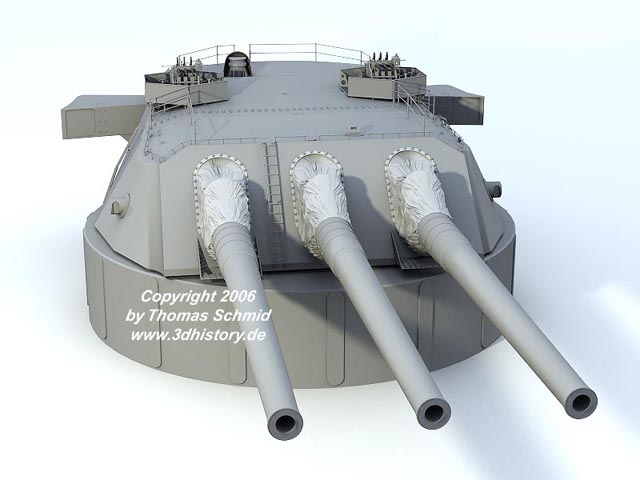 |
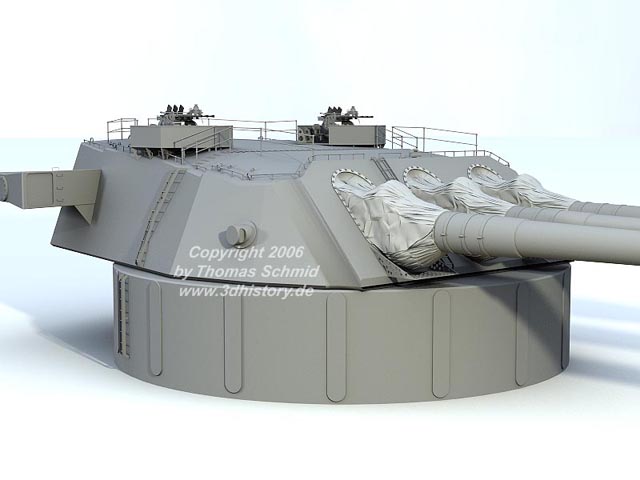 |
| From Internet 460mm (Internet) | From Internet 460mm (Internet) |
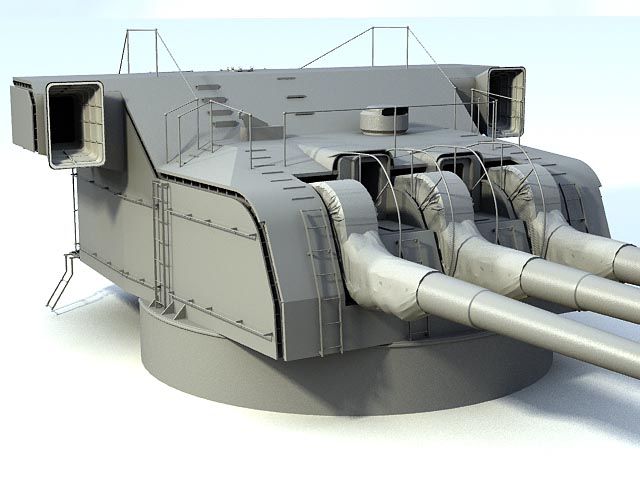 |
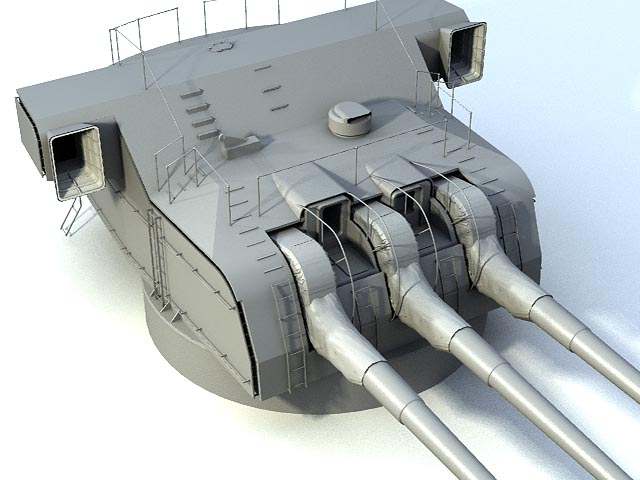 |
| From Internet 155 mm (Internet) | From Internet 155 mm (Internet) |
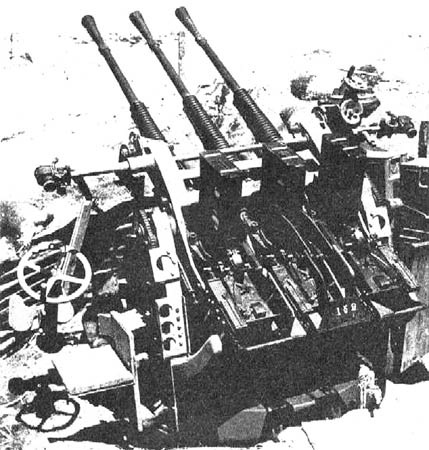 |
|
| From Internet 25 mm (Internet) | From Internet 25 mm (Internet) |
Therefore another designer who contributed to future battleship program was Vice Admiral Dr. Yuzuru Hiraga, director of the Naval Technical Research Laboratory. Hiraga presented his own private ideas of future battleships They stressed heavy armor protection and reduced the areas requiring this protection by squeezing the main battery and superstructure together as closely as possible. In all, the Hiraga design team proposed numerous designs (too numerous to go into here).In 1935, he proposed a fast battleship with all its heavy guns forward, possibly as a counter to HMS NELSON and RODNEY. The design was called A-140F6 and it is believed to be the original design for YAMATO:
Refinement of the design continued as detailed studies were made, and testing of models in a model basin led to the adoption of the bulnouss bow, which reduced hull resistance by 8%,
Plan No. A-140F6 was finalized at the end of March 1937, and a construction order issued at the beginning of August to the Kure naval Arsenal, where a construction dock was deepened, and gantry crane capacity increased to 100 tons. Construction of both initial vessels of the class was extraordinarily secret.
In the case of the Musashi, the entire construction-yard was roofed over to prevent observation of the ship before its completion.
The class was designed to be superior to any ship mostly US and English war ships
 |
| Shells of IJN Yamato (Internet) |
The 460 mm main guns were selected over 406 mm because never US Navy coud choose the caliber because the US ship cannot go trough the Panama canal (North Carolina and Iowa Class)
And tor confuse the intelligence agencies Yamato's main guns were officially named 40.6 cm Special
Here we found the little difference between the Yamato Original specifications and the real Yamato
| Yamato Project | Yamato | |
| Displacement standart | 68000 tons | 65000 tons |
| Dispalcement Trials | 69100 tons | |
| Length | 276 m | 262 m |
| Beam | 40 m | 36 m |
| Draft | 10 m | 10 m |
| HP | 200 000 | 147948 |
| Speed | 30 | 27 |
| Range | 9200 miles at 18 knots | 7200 miles at 16 knots |
| Armour Main Belt | 42 cm | 49 cm |
| Armour Deck | 10 | 24cm |
| Armement Main Battery | 9X 460 mm | 9X460mm(range 41 kms |
| Secondary | 12X155mm | 12X155mm |
| Anti Aircraft | 12X127 | 12x127mm 24x25mm 12x13mm |
| Aircraft | 0 | 6 |
IJN Yamato Construction in a specially prepared dock to hide her construction at Kure Naval Dockyards on November 4th 1937. Where the construction dock was deepened, to the Crane capacity (100 tons ),He was launched on
 |
| Kure Today the tanker is wer the Yamato was built (Internet) |
August 8th 1940 and commissioned December 16th 1941 Because of secret many designers and officers were not informed of the true dimensions of the battleship and the ship was launched, without formal commissioning ceremony
The designers submitted 21 proposals before one was accepted in July 1936.
 |
 |
| internet | internet |
The winner design show is a 62,000 ton ship equipped with nine 460 mm or 18-inch, 12 155 mm or 6-inch, 12X 127mmAA or 5-inch AA, 24X 25mm AA, and 16 X13mm guns.
He was powered by two shaft turbines of 75,000 HP and two shaft diesels of 60,000 HP. The diesels were 2-cycle double-acting engines
After the engines were changer and with this new engines the battleship's total power increased from 135,000 to 150,000. And the weight increase to 68,000 tons
Final design was approved in March 1937
The A turret was well depressed into the hull to decrease wind resistance. The bridge and superstructure was also designed to provide less wind resistance. To reduce wave resistance of the hull in the water a large bulbous bow was included
Although USA knew the existence of this ships he was only in 1942 whe arrive the confirmation with the first pics took upon the Truck Island base
At first USA the position of the ship had initially been interpreted as an island because of its size.
Operational Career
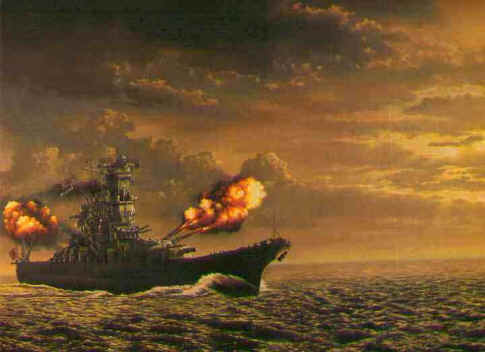 |
| From Internet |
IJN Yamato was the flagship of Admiral Yamamot from 12 February 1942, replacing IJN Nagato
In june 1942 he participate with as Yamamoto's Main Body at the attempted invasion of Midway Atoll in June 1942, but he took no active part in the battle
He remained the flagship for 364 days until 11 February 1943, when the flag was transferred to her sister ship IJN Musashi
From 29 August 1942 to 8 May 1943, she spent all of her time at Truk. In May 1943, the two wing 155 mm turrets were removed and replaced by 25 mm MG, and Type-22 surface search Radar were added.
He returned to Truk on 25 December 1943
He was damaged by a torpedo of the submarine USS Skate, and was not fully repaired until April 1944. During these repairs, AA protection was increases with additional 127 mm were installed in the place of the 155 mm turrets removed in May, and additional 25 mm AA guns were added.
In June1944 he participle at the Battle of the Philippine Sea follow in October by the Battle of Leyte Gulf However, her sister ship Musashi was finally sank Yamato support heavy attacks American sources report 10 torpedo hits to her port side, 9 to her starboard side, 17 bomb hits, and 18 near misses, while Japanese sources report 11 total torpedo hits, 10 bomb hits, and 6 near misses
Yamato return in Japan on November where his anti-aircraft capability was again upgraded over the winter.
On march 19th 1945 he was attacked 5 by carrier aircraft from TF 58, but suffered little damage.
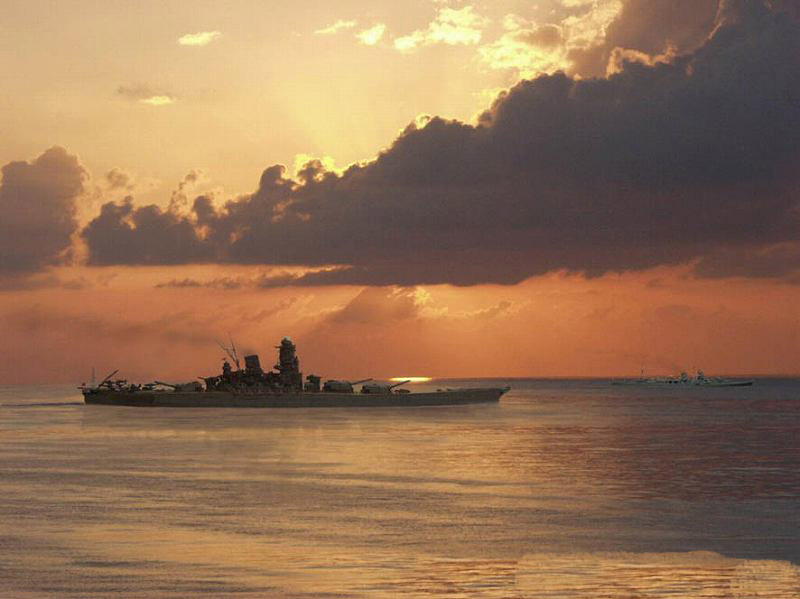 |
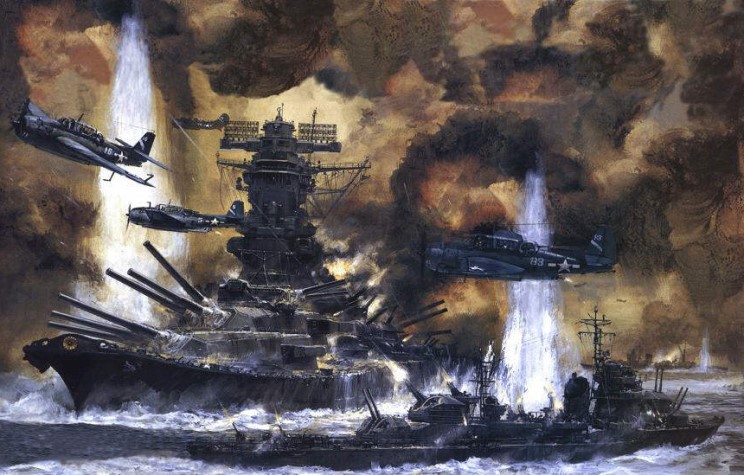 |
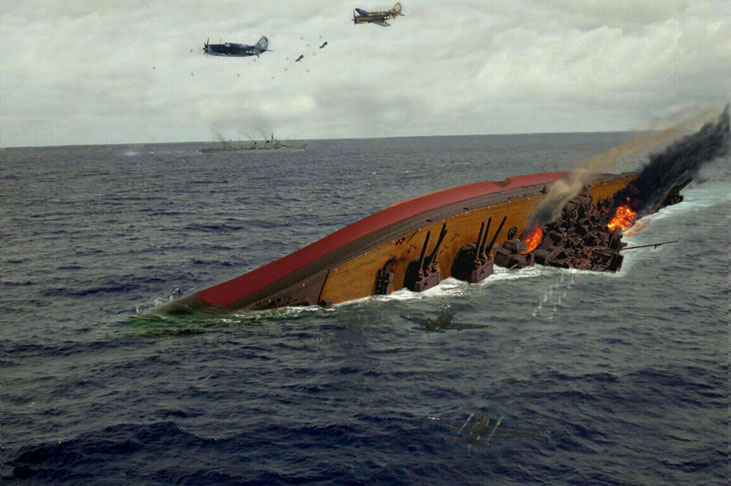 |
| Prelude (Internet) | Action (Internet) | End (Internet) |
On April 6th 1945, IJN Yamato was choose for on a suicidal mission against more than 1000 US ships in Okinawa. It his the Operation Ten GO
Thus IJN Yamato ended her career, as the ultimate kamikaze. On April 6th 1945, he go with one light cruiser and nine destroyers attack the US invasion fleet around Okinawa After fighting her way through, he was to beach herself on Okinawa and become a fortress to aid the defenders against the American ground troops. The next day, while still 270 miles north of Okinawa, the force was attacked by many aircraft from Task Force 58.
IJN Yamato took 13 torpedoes, 8 bombs and sank, killing 3,063 men
Epilog
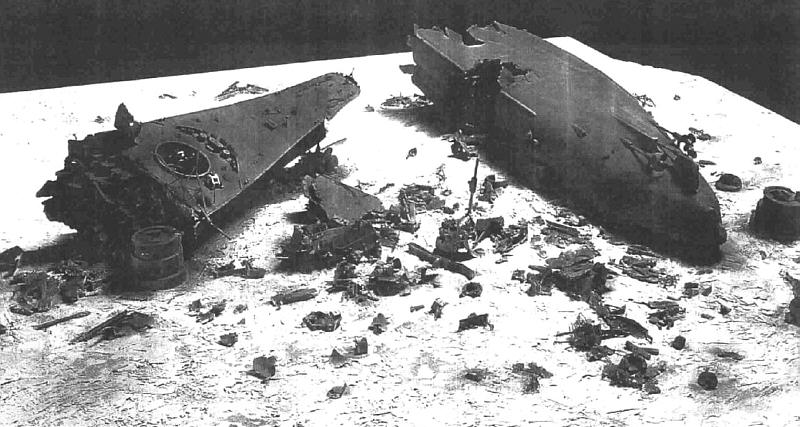 |
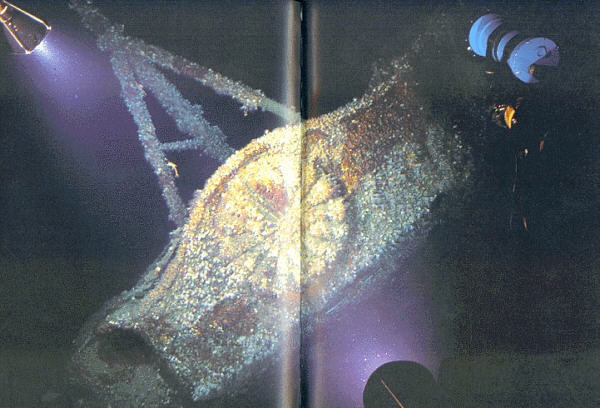 |
| From Internet | From Internet |
On August 1st 1985, a Japanese expedition using RESEARCH SUBMERSIBLE 2, located the wreck The ship was torn apart by a huge explosion forward of the aft 460mm turret asshe sank and the wreck is a tangled mess amidships. The fantail, with propellers, rudder and auxiliary rudder lies upside down in the mud. The forward hull, from the bow to the bridge area, lies on her starboard side, the number one 460mm gun barbette is empty andhalf-filled with mud. The number two 460 mm gun turret is still mounted and traversed about 120 degrees to starboard with the gun barrels buried in the mud. About 30 meters north of the main hull, lies an 460mm gun turret, upside down. About 70 meters south of the main hull, is a large section of hull, also upside down. The entire structure is slowly sinking into the mud. The Japanese plan no further expeditions and are respecting the wreck as a burial site for the 2,498 men that went down with her.
The other Yamato class
IJN Musashi
 |
He was the same but with a little beam (28m rather than t32m') with a displacement of 40,000 to 57,000 tons. He carry a main battery of 9X 460 mm or 16inch guns Construction hull began In 1937 at the Mitsubishi Nagasaki
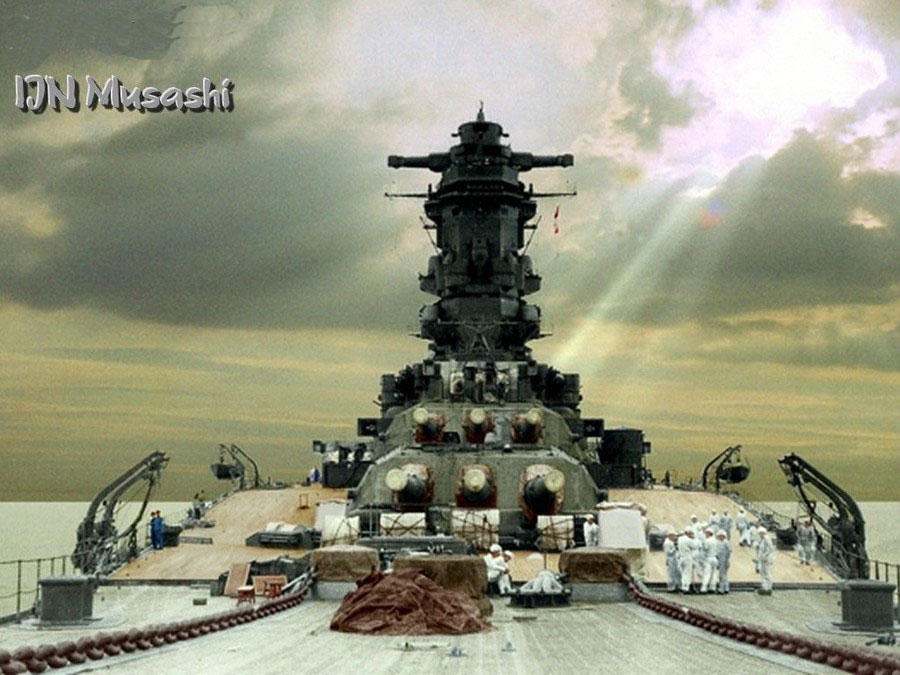 |
| From Internet |
Shipyard, where he was launched on November 1st 1940 and commissioned August 5th 1942.On October 24th 1944, while participating in the Battle for Leyte Gulf, IJN Musashi was attacked by aircraft from USS Enterprise, Cabot, Independence and Intrepid Over a 4 1/2hour period, she was hit by 17 bombs and 20 torpedoes and sank taking 1,023 officers and men with her, 43% of her complement
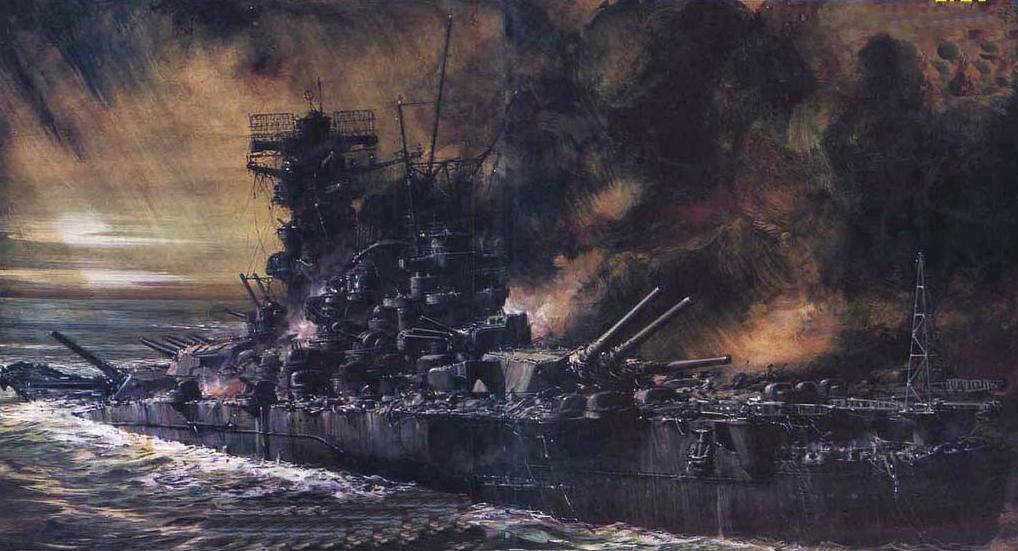 |
| End of IJN Musashi (Internet) |
.jpg) |
| End of Musashi From Internet |
IJN Shinano He began his life as War ship number 110. Laid down in May 1940, at t the Yokosuka Naval Arsenal it was believed she would not to be completed before 1945. Following the highly successful attack on Pearl Harbor, which showed the growing importance of air power, the Japanese were reluctant to commit the necessary manpower, construction space and money on another battleship. The work force was drastically reduced and the hull was to be completed only enough to float it out of the dock to clear that facility for other construction. The hull was 45% complete when, in June 1942, the decision was made to convert Number 110 into an aircraft carrier and name her Shinano. This decision was a direct result of Japan's staggering loss of four carriers at the Battle of Midway that same month. As a carrier she was to carry 20 fighters, 20 bombers and 7scouts. He was launched on October 8th 1944 Ten days after her commissioning on November 19th 1944, IJN Shinano was steaming from Yokosuka to Kure to pick up her air wing. Submarine USS Archerfish spotted her while patrolling the entrance to Tokyo Bay and fired six torpedoes, of which four struck. Six hours later, IJN Shinano sank with 75% of her crew
End o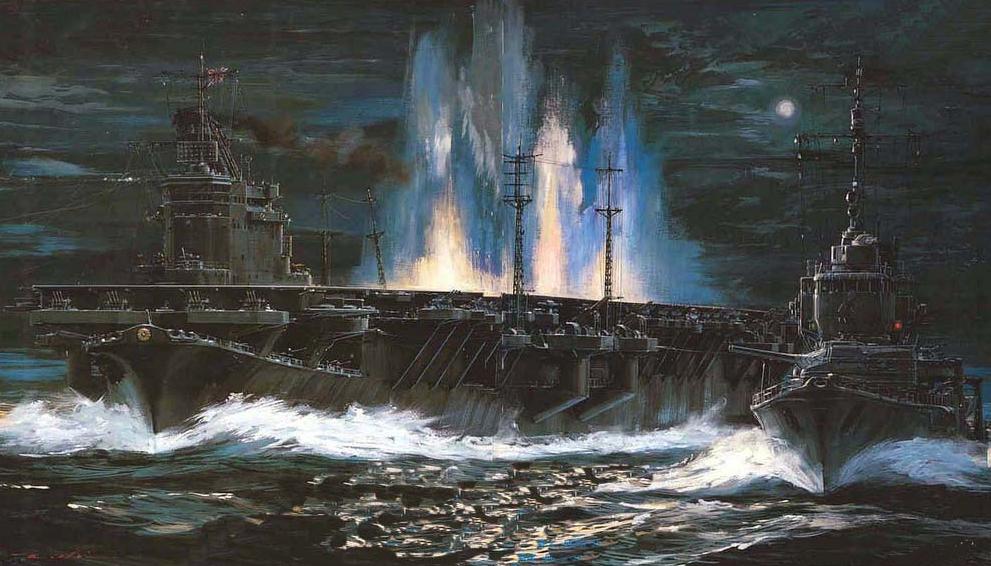 |
| End of IJN Shinano (Internet) |
.
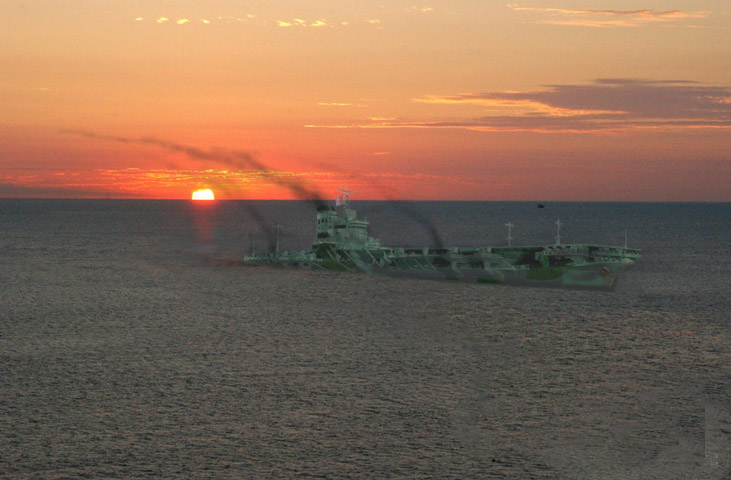 |
| End of Shinano From Internet (Internet) |
War Ship 111 he was never named, was to be the fourth Yamato Work was stopped when the hull was 30% complete in November 1941. The order was canceled in September the following year and hull was scrapped in 1943
War Ship 797, also never named, he was to be the fifth Yamato class battleship. This vessel was to have two 155mm triple turrets removed and replaced with a largebattery of 100mm anti-aircraft guns. No construction order was ever placed
War Ship 798 and 799 were to be the first Super Yamato class battleships. These were designed in 1941 with construction to begin the following year. The orders were never placed, so any specifications are rudimentary at best. These ships were also referred to as design A-150.
Specification of the A 150 Super Yamato
Displacement(tons) Standard 70,000 Trials 82,650
Armament 6x 510 mm or 20"/45 numerous 100mm/65 dual purpose
Speed 30 knots
Additional protection was planned and full-scale models of the magazines and handling rooms for the turrets were constructed. Ballistic tests were conducted on the 510 mm or 20 inch gun with an AP round that weighed 1.8 ton But no examples of this gun were found after the war
The Legend of Yamato
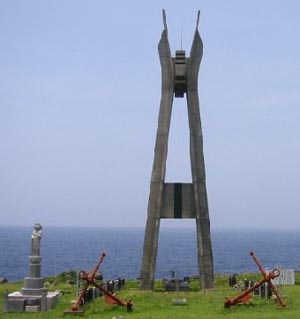 |